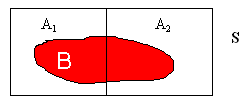45-733 PROBABILITY AND STATISTICS I Practice Midterm
Probability and Statistics
Name__________________________
Spring 1999 Flex-Mode and Flex-Time 45-733
Practice Midterm
Keith Poole
(10 Points)
1. How many ways can 10 people be seated around a circular table, taking into account only the relative location of the 10 people (that is, if all 10 people get up and move one chair to the right, the new arrangement is considered to be the same as the old arrangement)?Probability and Statistics
Name__________________________
Spring 1999 Flex-Mode and Flex-Time 45-733
Practice Midterm
Keith Poole
(10 Points)
2. Suppose we have the continuous bivariate probability distribution:
æ (3x - y)/5 1 < x < 2
f(x,y) = ç 1 < y < 3
è 0 otherwise
æ (6x - 4)/5 1 < x < 2
f1(x) = ç
è 0 otherwise
æ (9/2 - y)/5 1 < y < 3
f2(y) = ç
è 0 otherwise
Probability and Statistics
Name__________________________
Spring 1999 Flex-Mode and Flex-Time 45-733
Practice Midterm
Keith Poole
(10 Points)
3. Suppose 4 people are playing a game with a standard deck of 52 playing cards (as defined in class). If the 52 cards are randomly distributed to the 4 persons and each person receives exactly 13 cards, what is the probability that person A receives 5 spades, person B receives 4 spades, person C receives 3 spades, and person D receives 1 spade?
æ 13 öæ 39 ö
ç ÷ç ÷
è5 4 3 1øè8 9 10 12ø
P(E) = -----------------
æ 52 ö
ç ÷
è13 13 13 13ø
Probability and Statistics
Name__________________________
Spring 1999 Flex-Mode and Flex-Time 45-733
Practice Midterm
Keith Poole
(10 Points)
4. Suppose we have a continuous probability distribution
æ 2(1 - x) 0 < x < 1
f(x) = ç
è 0 otherwise
æ 0 x < 0
ç
F(x) = ç 2x - x2 0 £ x £ 1
ç
è 1 x > 1
Probability and Statistics
Name__________________________
Spring 1999 Flex-Mode and Flex-Time 45-733
Practice Midterm
Keith Poole
(10 Points)
5. Suppose we have the discrete bivariate probability distribution
æ c(3y - x) x=2,3
f(x,y) = ç y=2,3,4
è 0 otherwise
y
2 3 4
------------
2 | 4 7 10 | 21
x | |
3 | 3 6 9 | 18
| |
---------------
7 13 19 | 39
Therefore, c = 1/39Probability and Statistics
Name__________________________
Spring 1999 Flex-Mode and Flex-Time 45-733
Practice Midterm
Keith Poole
(10 Points)
6. An investor is interested in the stock of Amazon.Com. The investor feels that if the stock market goes up in the next year, the probability is .9 that the price of Amazon.Com stock will go up. If the market goes down, the probability is .4 that Amazon.Com stock will go up. Finally, if the market is unchanged, the probability is .7 that Amazon.Com stock will go up. In addition, the investor thinks that the probabilities are .5, .3, and .2 for the market to go up, go down, or remain unchanged. At the end of the year, the price of Amazon.Com stock has not gone up. What is the probability that the stock market went up?
Probability and Statistics
Name__________________________
Spring 1999 Flex-Mode and Flex-Time 45-733
Practice Midterm
Keith Poole
(10 Points)
7. Suppose we own a retail store and we keep track of the number of customer arrivals per hour. Let X be the number of customer arrivals per hour. Over a long period of time we find that:
æ .1 x = 0
ç
ç .2 x = 1
ç
ç .3 x = 2
ç
f(x) = ç .2 x = 3
ç
ç .1 x = 4
ç
ç .1 x = 5
ç
è 0 otherwise
Find E(X) and VAR(X).Probability and Statistics
Name__________________________
Spring 1999 Flex-Mode and Flex-Time 45-733
Practice Midterm
Keith Poole
(15 Points)
8. Suppose we have an electric circuit with 6 identical relays. The probability that a relay works when it is activated is .9 and the failures of the relays are independent. Let X be the number of open paths between A and B when the relays are activated. Find the probability distribution of X.
|--1--2--3--|
| |
A--|-----4-----|--B
| |
|--5-----6--|
æ .005149 x = 0
ç
ç .082143 x = 1
ç
f(x) = ç .381267 x = 2
ç
ç .531441 x = 3
ç
è 0 otherwise
Probability and Statistics
Name__________________________
Spring 1999 Flex-Mode and Flex-Time 45-733
Practice Midterm
Keith Poole
(10 Points)
9. We toss a coin 4 times. What is the probability we get 4 heads given that we get at least 2 heads?Probability and Statistics
Name__________________________
Spring 1999 Flex-Mode and Flex-Time 45-733
Practice Midterm
Keith Poole
(10 Points)
10. Suppose that the student population at Carnegie-Mellon is 65% male and 35% female and that 30% of the males smoke and that 20% of the females smoke. We randomly draw a student from this population and learn that the person smokes. What is the probability that the person is male?